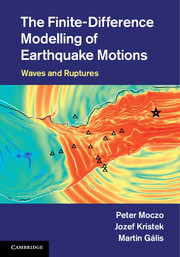
-
Select format
-
- Publisher:
- Cambridge University Press
- Publication date:
- May 2014
- April 2014
- ISBN:
- 9781139236911
- 9781107028814
- Dimensions:
- (247 x 174 mm)
- Weight & Pages:
- 0.92kg, 383 Pages
- Dimensions:
- Weight & Pages:
You may already have access via personal or institutional login
Book description
Among all the numerical methods in seismology, the finite-difference (FD) technique provides the best balance of accuracy and computational efficiency. This book offers a comprehensive introduction to FD and its applications to earthquake motion. Using a systematic tutorial approach, the book requires only undergraduate degree-level mathematics and provides a user-friendly explanation of the relevant theory. It explains FD schemes for solving wave equations and elastodynamic equations of motion in heterogeneous media, and provides an introduction to the rheology of viscoelastic and elastoplastic media. It also presents an advanced FD time-domain method for efficient numerical simulations of earthquake ground motion in realistic complex models of local surface sedimentary structures. Accompanied by a suite of online resources to help put the theory into practice, this is a vital resource for professionals and academic researchers using numerical seismological techniques, and graduate students in earthquake seismology, computational and numerical modelling, and applied mathematics.
Reviews
'This is an excellent book for those who wish to learn about the current state of the art of FD modeling of earthquake ground motion, bring themselves 'up to speed' in it, and apply it to their own research problems. Aside from the introductory chapters containing preliminary material, all chapters include detailed and comprehensive discussions of the various topics … Given that this book covers both past work and recent advances in the subject of the FD modeling of earthquake ground motion, it should make a significant contribution to the discipline.'
Edward S. Krebes Source: The Leading Edge
Contents
Metrics
Full text views
Full text views help Loading metrics...
Loading metrics...
* Views captured on Cambridge Core between #date#. This data will be updated every 24 hours.
Usage data cannot currently be displayed.
Accessibility standard: Unknown
Why this information is here
This section outlines the accessibility features of this content - including support for screen readers, full keyboard navigation and high-contrast display options. This may not be relevant for you.
Accessibility Information
Accessibility compliance for the PDF of this book is currently unknown and may be updated in the future.


